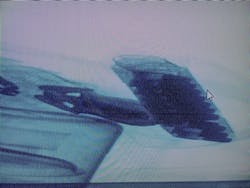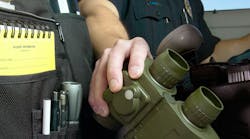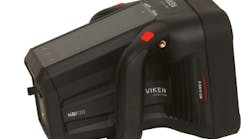Being able to see into or through something has long been identified as a strong capability, a game-changing capability for law enforcement professionals. Through the use of modern, and quickly advancing technology, that capability exists. How would you like to be able to see through the trunk of a suspect’s vehicle? Or inside a backpack without ever unzipping it? On a hostage barricade situation, would you like to be able to see inside the room where the suspect was holding hostages and know which was which?
One reality in law enforcement is that what you can’t see can kill you. While we all know that’s not always a true statement, it IS always a true possibility. Remember the academy? “Watch their hands!” One of the ten deadly errors is failing to watch the hands. If you can’t see the suspect’s hands, you are at risk. The same held true in low-light classes. “All dark holes have guns.” (As taught by the SureFire Academy back 2000.) Again, what you can’t see (because of the dark) might kill you.
Let’s take a look a two technologies developed to help you see into that unknown: A man-portable x-ray unit from Smart Imaging Systems Inc., and a through-wall technology from Camero-Tech, Ltd. The Smart Imaging Systems portable x-ray technology can allow you to see and develop a 3D image of a given object and its contents with amazing clarity. The through-wall imaging capability from Camero-Tech allows you to “see” through walls into a room and identify how many people are inside along with their relative positions. Welcome to the 21st century.
Smart Imaging Systems Inc. (SIS) invited me to their Maryland office for a general overview presentation. What I was introduced to is their man-portable, size adaptable, 3D capable x-ray technology. The two capabilities of this technology that set it apart from every other x-ray system were 1) its size / adaptability, and 2) the 3D capability.
The technology was developed for primary application mounted on a remote controlled robot commonly found in law enforcement special operations units like SWAT and bomb control units. However, the technology is adaptable and can be configured for temporary set up as a continuously belt-fed “table top” unit (as we see most often at airports for screening carry-on items), or it can be so big as to be able to scan automobiles, vans or even tractor-trailer size vehicles. In conjunction with the compact x-ray unit, due to the demands of a government customer, SIS also developed a custom remote controlled robot to carry their system. The portable x-ray system can be delivered by itself or it can be ordered as part of a package that includes the robot designed specifically to carry and use the unit.
The CEO was kind enough to set up a quick demo in their lab space. A typical book bag / back pack was put on the concrete floor and the robot / x-ray unit was used to scan it both along its width and length. Bear in mind, that took two passes with the unit: one along the pack’s length and one along its width. The images, via SIS’s proprietary software suite, can be combined to provide the 3D image of the pack and its contents.
The images were reasonably clear and the CEO was nice enough to point out what I was looking at: a hair brush, a compact CD player and a few other assorted odds and ends. Being the cynic that I am, I couldn’t help but wonder if they hadn’t given this presentation a few times before, which led my very suspicious mind to the thought that the images might have been preloaded. To test my theory I took off my badge and dropped it on top of the pack and then asked them to do the demonstration again. The CEO smiled and happily did so.
I wasn’t surprised by the fact that the resulting images revealed my badge but I WAS surprised at how easy it was to see the difference in density between the badge itself, the belt mount I wear it on and the clip in the mount. That led me to a curiosity and my next action. I pulled out one of the spare magazines for my handgun and dropped that on top of the pack and asked them to scan it again. My badge was identifiable, as is the magazine and the spring and cartridges inside it. It was easy to see the value in such a capability for everything from drug searches to physical security and counter-terrorism efforts.
From the time I dropped the magazine on top of the pack to when the images were available was about three minutes. The unit does require some training in the usage of x-ray technology—SIS provides such training with the delivery of their system.
While I have not seen the Camero-Tech product demonstrated, it’s been around and in use for quite a number of years now. As there are both military and law enforcement applications for it, it’s seen “real world” use in the hands of some of the most demanding users around our country (and deployed around the world). Camero-Tech’s XAVER systems use 3D Ultra Wide Band (UWB) imaging technology to deliver “through wall” and individual screening devices.
Their XAVER line of products include the XAVER 100 compact handheld through wall detector, the XAVER 400 (which is still small and relatively lightweight, but bigger than the 100 unit) and the XAVER 800 described as “a full 3D imaging solution for ISR applications.”
While the XAVER 100 sounds like it’s the most desirable to have because of its handheld size, the XAVER 800 unit really catches my eye. This tripod supported unit has four “wings” that fold out at each corner and a dedicated control/display unit. Once the unit is set up, the display provides visual information which allows you to map out the room on the other side of the wall to include room dimensions, the location of animate and inanimate objects, the height of animate (living) beings and the movement of such.
Consider the strength of having that information in a hostage barricade situation. If you can’t already see into the room, your breaching/rescue team can develop a plan without having to guess at the location of the people in a given room. They can know ahead of time which people are moving (usually bad guys) and which are stationary (usually hostages); which are standing (usually bad guys) and which are sitting, kneeling or laying down (usually hostages); which are closer to doors and windows (usually bad guys) and which are kept in the center or other controlled part of the room (usually hostages).
Even if you’re not looking at a hostage rescue scenario, but a simple high risk warrant service, you could identify how many suspects were in a given area, how many are moving around and how far from each access point they are. This kind of operational intel can be invaluable to successful raid planning and execution.
Like I said, welcome to the 21st century.


